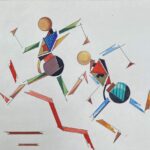World Pediatric Bone and Joint Day is an international initiative dedicated to raising awareness about the importance of bone and joint health in children. It is observed annually on 19 October. It aims to educate the public, healthcare professionals, and policymakers about the significance of early detection, prevention, and treatment of pediatric musculoskeletal conditions.
About Musculoskeletal disorders
Musculoskeletal disorders are any type of disease that affects the joints, ligaments, nerves, muscles, and bones. Musculoskeletal conditions in children and teenagers are becoming more common. Some examples of this type of condition include:
- Rheumatoid arthritis (RA)
- Bone fractures
- Tendinitis
- Developmental dysplasia of the hip
- Muscular dystrophy
- Osteoporosis
All of these disorders affect function and mobility. Some of the most common causes of musculoskeletal disorders in children include car accidents, playground accidents, and sports injuries. Other contributing factors to musculoskeletal disorders are obesity, poor posture, and Vitamin D deficiency.
According to the American Academy of Orthopedic Surgeons, more than 126 million Americans are impacted by musculoskeletal conditions. Many cases are brought on by obesity developed during childhood.
History of World Pediatric Bone and Joint Day
While the first Pediatric Bone and Joint Day — or PB&J Day — wasn’t celebrated until 2012, orthopedic medicine has far longer roots. Originally, the term “orthopedic” referred specifically to the correction of musculoskeletal deformities in children. Nicolas Andry, who was a professor of medicine at the University of Paris, coined the term in his textbook published in 1741. This book, which was directed towards parents, advocated for exercise, manipulation, and splinting to treat child bone deformities. 40 years later, In 1780, Jean-Andre Venel opened the first orthopedic institute, which was dedicated to treating children’s skeletal deformities.
The modern hip replacement was introduced in the 1960s by English tribologist Sir John Charnley, who made the connection that implants can be used to replace joint surfaces. He designed a one-piece stainless steel femoral stem & head and an acetabular component, both of which were used to fix the bone along with bone cement. The Charnley Low Friction Arthroplasty and designs that evolved from it were used for over two decades for hip replacement procedures. In the 1970s knee replacements, using similar technology, commenced for patients with rheumatoid arthritis.
USSR doctor, Gavril Abramovich Ilizarov, made a major contribution to orthopedic procedures without much training in the specialized field. Sent to look after Russian soldiers in 1950s Siberia, he came face to face with crippling conditions, infections, and bone malalignments. Employing the assistance of a nearby bicycle shop, he invented external ring fixators, similar to the spokes on a bike. With this, he was able to heal, realign, and lengthen to an unprecedented degree. The Ilizarov appartus is still used by surgeons to this day.
Theme of World Pediatric Bone and Joint Day 2023
World Pediatric Bone and Joint Day 2023 highlights obesity, screening, and prevention. The day also looks at symptoms, treatment, and economic impact.
How to Observe World Pediatric Bone and Joint Day
Celebrating World Pediatric Bone and Joint Day can involve various activities and initiatives aimed at raising awareness about pediatric musculoskeletal health. Here are some ways to celebrate and contribute to the cause:
- Organize awareness campaigns: Plan and execute awareness campaigns in local communities, schools, and healthcare facilities to educate parents, caregivers, and children about the importance of bone and joint health in early childhood development.
- Host educational seminars or webinars: Arrange seminars or webinars featuring healthcare professionals, experts, and specialists to discuss the prevention, diagnosis, and treatment of pediatric bone and joint disorders. These events can also provide valuable information about the importance of early intervention and management.
- Engage in social media campaigns: Utilize social media platforms to share informative content, personal stories, and relevant resources related to pediatric bone and joint health. Encourage the use of specific hashtags to promote the event and generate discussions about the significance of musculoskeletal health in children.
- Collaborate with local healthcare facilities: Partner with hospitals, clinics, and healthcare centers to conduct free or discounted bone and joint health screenings for children. This collaborative effort can help identify potential musculoskeletal issues early and facilitate timely interventions.
- Distribute educational materials: Develop and distribute informational brochures, pamphlets, and flyers that highlight the importance of maintaining healthy bone and joint development in children. These materials can include guidelines for preventive measures and recommendations for maintaining optimal musculoskeletal health.
- Engage in fundraising activities: Organize fundraising events to support research initiatives, treatment programs, and community outreach efforts focused on pediatric bone and joint health. Encourage local businesses, community members, and organizations to contribute to the cause.
- Foster partnerships with educational institutions: Collaborate with schools and educational institutions to integrate educational modules or workshops on bone and joint health into the curriculum. This can help instill healthy habits and practices among children from an early age.
- Advocate for policy changes: Work with policymakers and relevant authorities to advocate for improved access to quality healthcare services for children with musculoskeletal disorders. Raise awareness about the importance of healthcare policy reforms and increased support for research and treatment programs.
By participating in these activities and initiatives, individuals, organizations, and communities can actively contribute to the commemoration of World Pediatric Bone and Joint Day and promote the well-being and healthy development of children worldwide.
Tags: History of World Pediatric Bone and Joint Day, How to Observe World Pediatric Bone and Joint Day, Musculoskeletal disorders, Significance of World Pediatric Bone and Joint Day, Theme of World Pediatric Bone and Joint Day, World Pediatric Bone and Joint Day











